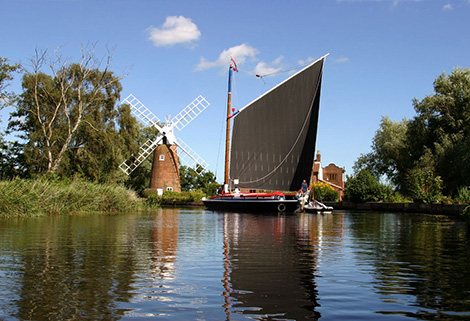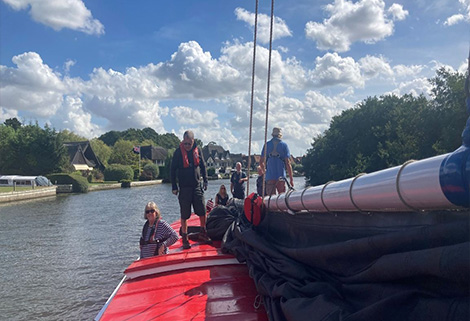albion adventure
I was very happy to attend the MNA Boat Club AGM in September 2022 at the little Norfolk Broads village of Neatishead. The following day I was able to take part in an event associated with the AGM – a day out on the Broads on the ‘Albion’.

The wherry 'Albion'
The ‘Albion’ is one of two surviving Norfolk Wherries, and the only one currently sailing. She is owned and operated by the Norfolk Wherry Trust who purchased her in 1949 in order to preserve her as an example of the Norfolk Wherry, the sailing barges who served the Norfolk Broads and were specifically adapted to the conditions prevailing there.
‘Albion’ is now 125 years old; some 65 feet overall and able to carry up to 40 tons of cargo. She is maintained in first class condition by the Trust and is operated by a team of volunteers and is funded mainly by passenger charters, one of which I joined.
I joined her at the Trust base at Womack near Ludham with some other Boat Club members – fortunately my Sat-Nav was able to find the location - and after a safety briefing and issue of lifejackets the ‘Albion’ got under way. We left our jackets etc. in the hold as it looked as though we were in for a warm shirt sleeves rig day, the hold also contains a toilet and a cooker and plenty of seating.
‘Albion’ is berthed in a little dock on the River Thurne. She has no engine but power is supplied by a dinghy with an outboard lashed to one quarter with a fender between. The outboard is usually operated by the Mate, who jumps into the dinghy to change the throttle setting when required. Security is maintained by a red safety line attached to the ‘Kill Cord’ and fastened on Albion’s quarter.
We set off down the River Thurne with this method and set the sail.
Perhaps a word about the ‘Albion’s unique rig might be useful at this point. The mast is unstayed, apart from a forestay, there is no other ‘Standing Rigging’. The mast is therefore a very substantial spar. It is stepped in an equally substantial Tabernacle at the fore end of the hatch and the foot is furnished with a very substantial counterweight, which rises up through the foredeck via a hatchway when the mast is lowered, by slackening the forestay purchase. The single sail is suspended from a very substantial gaff, which extends the sail such that the leach is practically vertical.
The halyard system is unique to the Norfolk Wherry. All other vessels with gaff sails have two sets of halyards, one for the Throat and one for the Peak. The wherry has one halyard which leads up from the deck through a double block at the mast head, through a single block at the throat of the gaff, back to the masthead block, down to a block with a span attached to a couple of points on the gaff, and leads up to and is finally made fast to the masthead block. The sail is then hoisted by the halyard led to a geared winch at the fore side of the mast. The sail was actually hoisted on this occasion by myself and another Boat Club member, and it was not a very heavy job.
We sailed down the Thurne and then ascended the river Bure. The conditions were a mainly cloudy day with light winds, often diminished and diverted by vegetation on the banks and thus we were able to experience every point of sailing many times, and in rapid succession! ‘Albion’ tacked and gybed as necessary with little fuss, assisted by the dinghy outboard when necessary, the throttle operated by the Mate who jumped into the dinghy from his normal position by the little knee-high ‘cockpit’ at the after end of the hatch from where he also tended the mainsheet, cleated on the after end of the coaming, where necessary.
We arrived at Horning which was our lunch stop, and where some of the passengers departed and our MNA President, Vivien Foster OBE, joined us for the return trip. I had elected to stay on board ‘Albion’ for the whole day as being a unique experience, not to be missed. I was offered a spell at the helm which I enthusiastically accepted. She is steered by a very large rudder, some six feet in length, which is controlled by a substantial tiller operated from the little knee-high cockpit which also leads by a further step down into a little cuddy, crew accommodation when she was working. The only helm order I was given was ‘Keep her in the middle’, which I endeavoured to do. Not surprisingly she takes a little while to respond to her helm, and a bit of anticipation as to when to take helm off is required, she certainly is not hard to steer in those conditions.
We noticed some black rain clouds creeping across the Broads to one side of us but thought that they would probably pass astern, so we continued to sail in our shirt-sleeve rig. Most other traffic has given us right-of-way up to this point, indeed the Skipper had told us that we had precedence over most other traffic on the Broads. However, at this moment a charter sailing yacht crossed our bows and then tacked back, putting her on a collision course.
The Skipper ordered the helm over and told the Mate to let go the Mainsheet to depower the sail. As she started to respond we were suddenly engulfed in a heavy rainstorm with a heavy gust of wind; with which, with the helm already over and the mainsail running out to right-angles, ‘Albion’ headed for the reeds along the bank, where she remained pressed to the bank.
The mainsheet continued to run out and unrove and the sail, with no Standing Rigging to inhibit it, continued around to the fore side of the mast. The downpour continued and all hands, including Vivien our President sitting on the foredeck, were drenched to the skin by this time!
The Skipper suggested that I step into the Cuddy, I don’t think that this was in consideration for my welfare, because as well as himself and the Mate there was also a Trainee Skipper and a Trainee Mate on board and I am sure that he decided that he needed experienced hands at a time like that. I might therefore be slightly adrift as to the sequence of events following.

Norfolk Wherry 'Albion'
The squall had eased and the first task was to re-reeve the mainsheet and get the sail back abaft the mast, the sail was then lowered onto the deck and the task of getting her off the bank was commenced. This was accomplished by the use of the dinghy with its outboard and the use of the ‘Quants’; long poles with a fork on the bottom and a shoulder button on the top used to pole the vessel in the way that a punt is propelled by punt poles.
Once ‘Albion’ was under way, with propulsion provided by the dinghy, it was noticed that there were lightning flashes visible close by. Standing Orders are that in the event of lightning, the mast is to be lowered, so the forestay purchase was slackened off and down came the mast to join the gaff and sail on top of the hatch.
It was then time to get below and remove my sodden shirt. A kind member of the crew kindly loaned me a dry tee shirt to wear under my waterproof jacket, now perhaps a bit superfluous! When I returned it when we docked, it was sopping wet below the waist where it had been in contact with my wet trousers!
I did have the temerity to ask the Skipper, trying not to teach granny to suck eggs, whether it would not be useful to have a figure-of-eight knot on the end of the Mainsheet. He replied that they had given some consideration to this very point and had decided that; in the event of having to let go the mainsheet for any reason, it was better for the sail, unencumbered by any Standing Rigging, to go forward of the mast to de-power it. I have to admit that this made good sense.
Thus we returned under power to our dock, where we helped to turn her and back her in to her usual berth. So ended a very interesting and enjoyable day, enlivened by a bit of excitement!
I was most interested to learn more about this unique sailing craft, evolved to satisfy the local conditions on the Broads which I had only read about before. I knew something about the evolution, equipment and handling of the other classic British sailing barge, the Thames ‘Spritty’, of which there are many surviving still, but I can only applaud the efforts of the Norfolk Wherry Trust in maintaining and operating this almost unique example – there is another partly restored privately owned wherry in the Trust’s dock, but she is not rigged at present.
